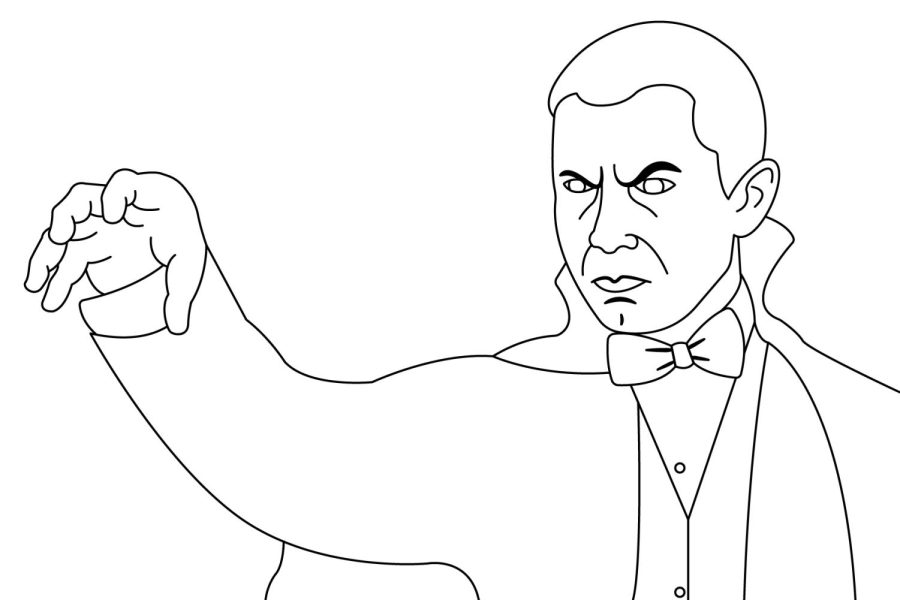The Vampire and Its Cultural History
Dr. Stanley and Dr. Gillota present in LAE Faculty Forum
Dr. Adam Stanley, Professor of History, presented on the history of vampires as cultural phenomena in European history on Oct. 5 as part of the College of Liberal Arts and Education Faculty Forum series. Dr. David Gillota, Associate Professor of English, responded to Dr. Stanley’s presentations with a brief overview of vampire imagery in film.
Dr. Hilton Kelly, Dean of LAE, introduced the event by sharing an anecdote of some of his research history. He concluded, “The very function of the faculty forum is to provide a space for faculty to share ideas that have haunted them … to present the intellectual puzzle that they are grappling with.”
The intellectual puzzle of vampires in literature and in culture began to haunt Dr. Stanley during the pandemic, during which he read Bram Stoker’s “Dracula.”
Dr. Stanley was interested, in particular, with “how the undead came alive, how was it that this imagery of the vampire as a specific creature emerged, developed and evolved in the European cultural imagination.”
He noted, too, that this timeline of development mainly “happened in the 18th and 19th century, culminating in 1897 with the publication of “Dracula” by Bram Stoker.”
The idea of the vampire began in the Eastern European cultures, showing up as “proto-vampires,” as Dr. Stanley coined, in Slavic words like “upyr, oupir, vepyr, vepir,” which all described a “reanimated corpse that tormented living creatures and, somehow, took their blood.”
At this time, as early as the 14th or 15th century, the rules of the myth of the proto-vampires were not solidified like they are today. As the proto-vampire myths broadened their geographical range into the larger European mind, people attempted to explore the nature of the vampire.
“Natural philosophers were having their heyday coming out of the Scientific Revolution where they had made so many different advances and were rooted in nature. So scientific thinkers were determined to seek and understand these tales, not as being of supernatural origin … but on the terms of natural phenomenon.”
When the scientific community could not rationalize the existence of vampires, the task moved to religious philosophers. This was a daunting task. Christian religious philosophers, for instance, had to decipher how Jesus Christ had died and risen from the dead in a dissimilar fashion than a vampire had died and risen from the dead.
These debates continued and created a cultural footprint that historians can still observe and measure today. The first Encyclopedia, published in the 1750s, and serving as a compendium of collective knowledge, includes an entry of vampires.
In this period of the 1700s, gothic writing styles began to explode in popularity. This genre sought to integrate fantastical elements (like vampires), darkness and the macabre into realistic elements of medieval or current times, culture, technology and progress.
The codified rules of vampires started showing up more consistently in the 1800s with “Verney the Vampire,” “Carmilla” and finally “Dracula.” Readership and viewership of theatrical adaptions propelled the vampire myth further towards the general understanding of the rules of vampires.
Technological advances in the 1900s allowed for movie-goers to watch a different form of live-action depiction of the now-solidified myth of the vampire. Two prominent depictions that paved the way for cultural understanding were “Nosferatu” and Bela Lugosi’s “Dracula.” Here, the modern dichotomy of the gross and monstruous vampire and the handsome and alluring vampire arose.
The myth of the vampire is, much like its subject, not dead. In perfect reflection of vampires, vampire-centric media continues to undergo cycles of death and rebirth. Recently, media like “What We Do In The Shadows” have reshaped the general rules of vampires away from the serious, monstruous, alluring, or seductive creatures to joking and sometimes incompetent creatures.




